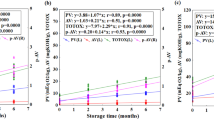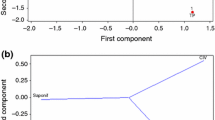Abstract
A new differential scanning calorimetry (DSC) method was developed for the determination of total polar compounds (TPC) in heated oils. Three different types of edible oils, refined, bleached, and deodorized corn oil (CO), palm olein (RBDPO), and soybean oil (SO), were used in this study, Each type of edible oil was heated at 180°C in a deep fryer to obtain a range of TPC concentrations. In this study, the cooling thermograms of oil samples at a scanning rate of 1°C/min from −30 to −85°C showed a well-defined single crystallization peak. The study found that six DSC parameters, namely, peak temperature (PT), enthalpy (EN), onset (ON) and offset (OF) temperatures, peak height (HT), and the range of temperatures (RT) (the difference between onset and offset temperature) of this single crystallization peak could predict well the TPC of heated oils by using stepwise multiple linear regression analysis. These six parameters were used as independent variables while values from standard method were used as dependent variables. The coefficient of determination (R 2) of calibration models for CO, RBDPO, and SO were 0.9996, 0.9709, and 0.9980, respectively. Calibration models were validated with an independent set of samples. The R 2 of validation models were 0.9995, 0.9559, and 0.9961, respectively. Based on the results obtained, DSC appears to be useful instrumental method in determining the TPC of edible oils, and it may have the potential to replace the time- and chemical-consuming standard method.
Similar content being viewed by others
References
White, P.J., Methods for Measuring Changes in Deep-Fat Frying Oils, Food Technol. 45:75–80 (1991).
Chung, T.Y., J.P. Eiserich, and T. Shibamoto, Volatile Compounds Identified in Headspace Samples of Peanut Oil Heated under Temperatures Ranging from 50 to 200°C, J. Agric. Food Chem. 41:1467–1470 (1993).
Wu, C.M., and S.Y. Chen, Volatile Compounds in Oils After Deep Frying or Stir-Frying and Subsequent Storage, J. Am. Oil Chem. Soc. 69:858–865 (1992).
Gardner, D.R., R.A. Sanders, D.E. Henry, D.H. Tallmadge, and H.W. Wharton, Characterization of Used Frying Oils. Part 1: Isolation and Identification of Compound Classes, Ibid.:499–508 (1992)
Gere, A., Study of the Changes in Edible Fats During Heating and Frying, Die Nahrung 26:923–926 (1982).
Clark, W.L., and G.W. Serbia, Safety Aspects of Frying Fats and Oils, Food Technol. 45(2):84–86,88,89,94 (1991).
Robards, K., A.F. Kerr, and E. Patsalides, Rancidity and Its Measurement in Edible Oils and Snack Foods, Analyst 113:213–222 (1988).
Fritsch, C.W., Measurements of Frying Fat Deterioration: A Brief Review, J. Am. Oil Chem. Soc. 58:272–274 (1981).
Paul, S., and G.S. Mittal, Regulating the Use of Degraded Oil/Fat in Deep-Fat/Oil Food Frying, Crit. Rev. Food Sci. Nutr. 37:635–662 (1997).
Blumenthal, M.M., A New Look at the Chemistry and Physics of Deep-Fat Frying, Food Technol. 45(2):68–71,72 (1991).
Firestone, D., R.F. Stier, and M.M. Blumenthal, Regulation of Frying Fats and Oils, Ibid.(2):90–94 (1991).
AOCS, Official Methods and Recommended Practices of the American Oil Chemists’ Society, 4th edn., AOCS Press, Champaign, 1993, Method Cd 20–91.
Pokorný, J., Flavor Chemistry of Deep Fat Frying in Oil, in Flavor Chemistry of Lipid Foods, edited by D.B. Min, and T.H. Smouse, American Oil Chemists Society, Champaign, 1989, pp. 113–155.
Blumenthal, M.M., Frying Technology, in Bailey’s Industrial Oil and Fat Products, 5th edn., edited by Y.H. Hui, John Wiley & Sons, Inc., New York, Vol. 3 1996, pp. 429–482.
Herrera, M.L. and M.C. Anon, Crystalline Fractionation of Hydrogenated Sunflowerseed Oil. II. Differential Scanning Calorimetry (DSC), J. Am. Oil Chem. Soc. 68:799–803 (1991).
Kawamura, K., The DSC Thermal Analysis of Crystallization Behavior in Palm Oil, Ibid.:753–758 (1979).
Md. Ali, A.R., and P.S. Dimick, Thermal Analysis of Palm Mid-Fraction, Cocoa Butter, and Milk Fat Blends by Differential Scanning Calorimetry, Ibid.:299–302 (1994).
Jacobsberg, B., and O.C. Ho, Studies in Palm Oil Crystallization, Ibid.:609–617 (1976).
Melton, S.L., S. Jafar, D. Sykes, and M.K. Trigiano, Review of Stability Measurements for Frying Oils and Fried Food Flavor, Ibid.:1301–1308 (1994).
Biliaderis, C.G., Differential Scanning Calorimetry in Food Research—A Review, Food Chem. 10:239–265 (1983).
Dollimore, D., Thermal Analysis, Anal. Chem. 68:63R-71R (1996).
Haryati, T., Y.B. Che Man, A.B. Asbi, H.M. Ghazali, and L. Buana, Determination of Iodine Value of Palm Oil by Differential Scanning Calorimetry, J. Am. Oil Chem. Soc. 74:939–942 (1997).
Walker, R.C., and W.A. Bosin, Comparison of SFI, DSC, and NMR Methods for Determining Solid-Liquid Ratios in Fats. Ibid.:50–53 (1971).
Sessa, D.J., T.C. Nelsen, R. Kleiman, and J.D. Arquette, Differential Scanning Calorimetry Index for Estimating Level of Saturation in Transesterified Wax Esters, Ibid.:271–273 (1996).
7 Series/UNIX DSC7 Users Manual, Version 4.0, Perkin Elmer Corporation, Norwalk, CT, 1995.
SAS, Statistical Analysis System User’s Guide: Basic Statistics, SAS Institute, Cary, 1989.
Barbano, P., and J.W. Sherbon, Phase Behavior of Tristearin/Trioctanoin Mixtures, J. Am. Oil Chem. Soc. 55:478–481 (1978).
Hagemann, J.W., and W.H. Tallent, Differential Scanning Calorimetry of Single Acid Triglycerides: Effect of Chain Length and Unsaturation, Ibid.:119–123 (1972).
Berger, K.G., and E.E. Akehurst, Some Application of Differential Thermal Analysis to Oils and Fats, J. Food Technol. 1:237–247 (1966).
Che Man, Y.B., and P.Z. Swe, Thermal Analysis of Failed-Batch Palm Oil by Differential Scanning Calorimetry, J. Am. Oil Chem. Soc. 72:1529–1532 (1995).
Miller, J.N., Outliers in Experimental Data and Their Treatment, Analyst 118:455–461 (1993).
Author information
Authors and Affiliations
Corresponding author
About this article
Cite this article
Tan, C.P., Che Man, Y.B. Quantitative differential scanning calorimetric analysis for determining total polar compounds in heated oils. J Am Oil Chem Soc 76, 1047–1057 (1999). https://doi.org/10.1007/s11746-999-0203-3
Received:
Accepted:
Issue Date:
DOI: https://doi.org/10.1007/s11746-999-0203-3




